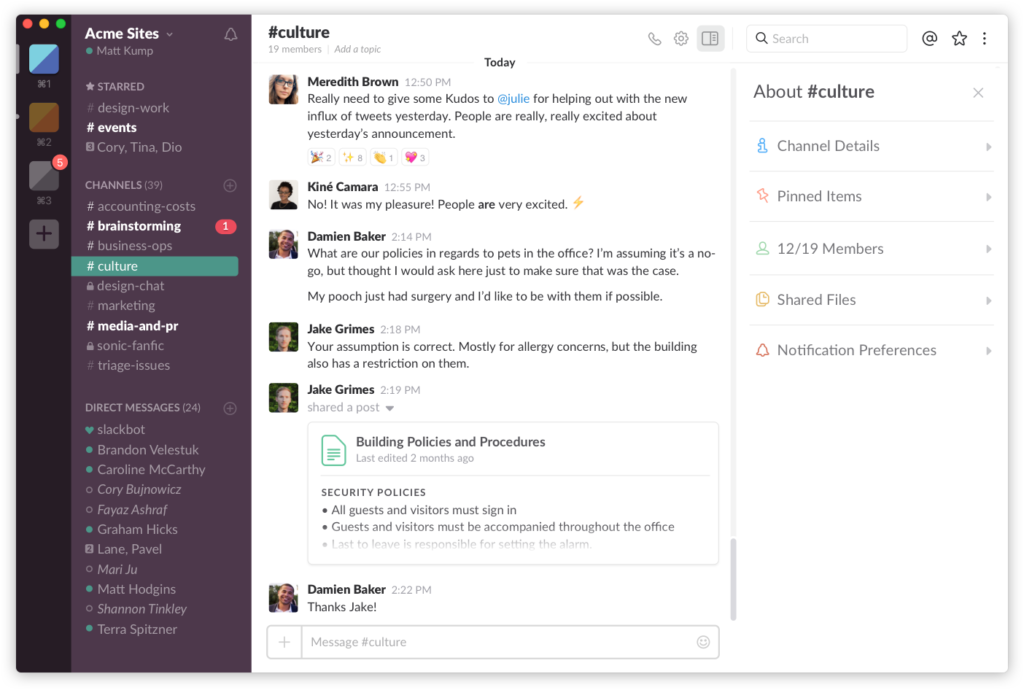I cannot think of a digital workplace tool, since SharePoint, that has received so much attention and ink as Slack. It’s very popular, widespread and extremely hip, particularly with the media and technology pundits. Even Vanity Fair has dedicated some of its oh-so-fashionable pages to the hipster app (Slack, The Group-Chat App Everyone Hates To Love…).
A look at the numbers reveals an intriguing tale:
- Estimated market: value $9 billion
- Annual revenue: $150 million
- Daily users: 5 million
- Paid users: 1.5 million
- Number of teams: 60,000
Well if 1.5 million paid users equals a street valuation of $9 billion, then I guess Blue Mountain Arts was worth nearly $800 million.
But let’s call a spade a spade: Slack is a chat app. A very good one, but it doesn’t replace anything.
There’s no doubt about it, Slack has cut into Skype’s market. But really, so far, it’s only a sliver. It’s estimated that Skype has 76 million active users, and more than 500 million have used it in total. But in terms of functionality, and utility as a digital workplace tool, Slack is far superior: group chat, threaded conversations, sharing files, and integration with other apps and services, such as Skype for video calls.
But does it replace Skype? No.
Does it replace email? No.
Does it replace the intranet? No.
Slack is only one tool in the digital workplace, but as many users report, it can create more problems than it solves.
“To say the app was a game-changer would be putting it mildly. Communication between team members across continents exploded,” says Amir Salihefendic, of Doist, in his post Why we’re betting against real-time team messaging.
“Almost overnight, we went from a group of thirty individuals to a true team. And then, two years in, we quit Slack cold turkey.”
The problem? Slack is too much of a distraction, too overwhelming, and it doesn’t replace email or other collaboration tools.
“Slack was useful for quickly checking on things, but we found that it was a troublesome channel for big picture discussions,” adds Amir. “Group chat interfaces are designed for rapid fire messaging, and it was nearly impossible to sustain a full conversation from start to finish.
Many frustrated users report that Slack is much like a forest fire: it spreads rapidly, it generates great heat and excitement, but is massively disorganized, unpredictable, and overwhelming.
Dave Teare, founder of AgileBits, says that Slack left him in “in a constant state of anxiety, feeling that I needed to always be on guard.”
“This made me realize that our use of Slack was even more destructive than I had realized. The time pressures forced me to be curt and I avoided taking the time to be playful. Worse, since I was in a constant state of heighten[ed] anxiety, I often wouldn’t feel like being playful to begin with.”
Slack is yet another reminder of how technology does not work without a plan, with defined rules and processes, and must be accompanied with the mission-critical requisite change management that instructs employees accordingly.
With the right plans and rules, Slack is a great chat app. However, since it doesn’t replace email, Skype, or any other tool, the answer is no: Slack is not worth the hype.
As a far superior alternative, one that works well with SharePoint and is already integrated into Office 365, Microsoft Teams is an app to keep an eye on.
—
Toby Ward is the founder of Prescient Digital Media, and the founder and chair of the Digital Workplace & Intranet Global Forum. You can subscribe to his Intranet Insight newsletter for free.
